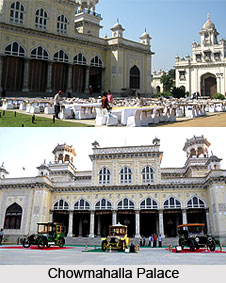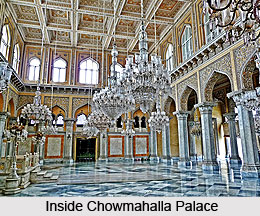 Architecture of Chowmahalla Palace deals with the conglomeration of the four palaces like Afzal Mahal, Mahtab Mahal, Tahniyat Mahal and Aftab Mahal. It is now a private property of Nizams. One part of Chowmahalla Palace is now museum and library and another part now acts as an event hosting place for regal couples.
Architecture of Chowmahalla Palace deals with the conglomeration of the four palaces like Afzal Mahal, Mahtab Mahal, Tahniyat Mahal and Aftab Mahal. It is now a private property of Nizams. One part of Chowmahalla Palace is now museum and library and another part now acts as an event hosting place for regal couples.
Chowmahalla Palace or Chowmahallat or the home of 4 Palaces, is a palace of the Nizams of Hyderabad. It was the seat of the Asaf Jahi dynasty and was the official residence of the Nizams of Hyderabad while they ruled their state. The palace remains the property of Barkat Ali Khan Mukarram Jah, the successor of the Nizams of Hyderabad.
While Nizam Salabhat Jung is accredited with initiating the construction of the palace complex in the year 1750, Nizam Afzar-ud-Dawla Bahadur ensured that he would complete the construction of Chowmahalla Palace. It was completed in between 1857 and 1869.
Chowmahalla Palace was extended from the Laad Bazaar on the north to the Aspan Chowk Road on the south. Chowmahalla Palace originally covered 45 acres but regrettably only 12 acres remains for the tourists.
Southern courtyard of Chowmahalla Palace
Southern courtyard of Chowmahalla Palace is the oldest part of the palace and has four palaces Afzal Mahal, Mahtab Mahal, Tahniyat Mahal and Aftab Mahal. It was built in the neo-classical style of Islamic architecture.
 Northern courtyard of Chowmahalla Palace
Northern courtyard of Chowmahalla Palace
Northern courtyard of Chowmahalla Palace part has Bara Imam, a long corridor of rooms on the east side facing the central fountain and pool that, once housed the administrative wing and Shishe-Alat meaning mirror image. It has Mughal domes and arches and many Persian elements like the ornate stucco work that adorn the Khilwat Mubarak. These were characteristic of buildings built in Hyderabad during the later phase of medieval rule. Opposite to the Bara Imam is a building that is its shishe or mirror image. The rooms were used as guest rooms for officials accompanying the visiting foreign and regal dignitaries.
Watch Tower Gate of Chowmahalla Palace
Watch Tower Gate is heart of Chowmahalla Palace. It is held in high admiration by the people of Hyderabad, as it was the seat of the Asaf Jahi dynasty. The grand pillared Durbar Hall of Chowmahalla Palace has a pure marble platform on which the Takht-e-Nishan or the royal seat was laid. In this palace, the Nizams held their durbar and other religious and symbolic ceremonies. The 19 spectacular Chandeliers of Belgian crystal recently reinstalled to recreate the lost splendour of this majestic hall.
Clock Tower of Chowmahalla Palace
The clock of Chowmahalla Palace is placed above the main gate to Chowmahalla Palace. This is affectionately called as Khilwat Clock. It has been ticking away for around 250 years. An expert family of clock repairers winds the mechanical clock every week.
Council Hall of Chowmahalla Palace
The council hall of Chowmahalla Palace housed a rare collection of manuscripts and priceless books. The Nizams of Hyderabad often met important officials and dignitaries here. Today, it is the site for impermanent exhibitions from the treasures of the Chowmahalla Palace.



















